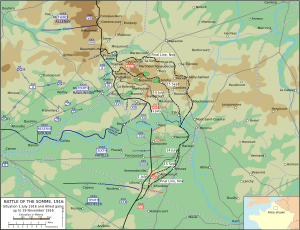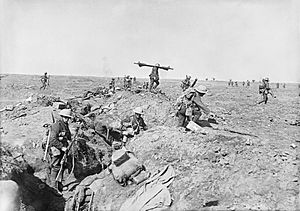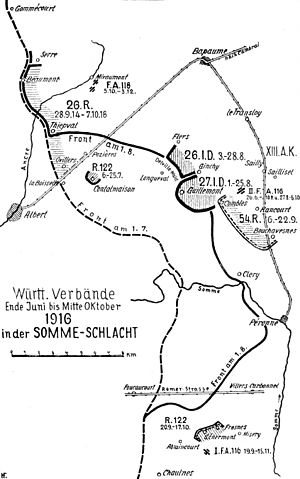Battle of Morval facts for kids
Quick facts for kids Battle of Morval |
|||||||
|---|---|---|---|---|---|---|---|
| Part of the Battle of the Somme of the First World War | |||||||
 Battle of the Somme 1 July – 18 November 1916 |
|||||||
|
|||||||
| Belligerents | |||||||
|
|||||||
| Commanders and leaders | |||||||
Henry Rawlinson Ferdinand Foch Émile Fayolle |
Fritz von Below |
||||||
| Strength | |||||||
| 11 British divisions 7 French divisions |
4 divisions | ||||||
| Casualties and losses | |||||||
| 5,000 | 135,000 in September | ||||||
| Casualty statistics are incomplete and German losses at Morval are a portion of the September total. | |||||||
The Battle of Morval happened from September 25 to 28, 1916. It was a major attack during the Battle of the Somme in World War I. British and French armies worked together. They aimed to capture the villages of Morval, Gueudecourt, and Lesbœufs in France. These villages were strongly held by the German army.
The attack was planned to push the German lines back. It also aimed to stop the Germans from sending help to their troops further west. Bad weather, like rain, often delayed these plans. Despite the delays, the British and French captured all their targets. They caused many losses for the German forces. This battle was one of the deepest advances the British made in the Somme.
However, the soldiers were very tired. There were not enough fresh troops to keep pushing forward. The weather also got worse, making it hard to move supplies. Rain and fog made it difficult for planes to fly and for artillery to aim. Mud made it hard for soldiers to move and for shells to explode properly. A few tanks joined the fight later. They helped destroy some German strong points.
Why the Battle Happened
Big Plans for the War
By August 1916, the Allies (Britain, France, and Russia) felt hopeful. A big Russian attack was keeping German and Austro-Hungarian troops busy. Germany had also stopped its attacks at Verdun, France.
British General Douglas Haig wanted to keep fighting the Germans hard. He hoped new tanks would be ready for September. Even though there were few tanks, he used them. This was part of a bigger plan to attack the Germans on all fronts. Haig believed the German defenses were getting weaker. He thought they might even collapse by mid-September.
Getting Ready for Battle
British and French Preparations
After earlier attacks in September, the British and French kept up the pressure. They launched smaller attacks to keep the Germans off balance. The British captured an important German trench system.
Both the French Sixth Army and the British Fourth Army got ready for bigger attacks. More artillery (big guns) and aircraft were brought in. The French army also got more soldiers.
Careful planning was needed because the French army was moving in a different direction. The main attack was planned for September 21. But bad weather made them wait until September 25. Heavy mist and haze on September 24 made it hard for the artillery to aim.
The French and British commanders met to coordinate their plans. They decided to move the boundary between their armies. This gave the French more space to attack.
British and French Battle Plans
The French planned to advance about 3,000 yards (2,700 meters). Their goal was to reach the German line near Moislains and Le Transloy. They also wanted to secure their flank (side) along a stream.
The British planned to reach their final targets from earlier attacks. These targets were on a ridge east of Bazentin. The advance would happen in stages. Soldiers would move forward, stop, and then move again.
Tanks were considered for the attack. But it was decided to keep them in reserve at first. They would be used to help capture the villages later. Cavalry (soldiers on horseback) were also ready. They would push forward if the German defenses broke.
The British agreed to attack in the afternoon, like the French. This meant the final artillery bombardment would happen in daylight. British generals usually preferred dawn attacks.
German Preparations
Germany changed its army command structure in August. This was to better control their forces on the Western Front. New leaders, Field Marshal Paul von Hindenburg and General Erich Ludendorff, took over. They stopped attacks at Verdun and sent more troops to the Somme. This helped Germany have more guns and planes.
German artillery became more accurate. They used planes to spot targets. New "relief divisions" were kept behind the front lines. These fresh troops could quickly replace tired divisions. German counter-attacks became stronger and more frequent.
The Germans also changed their defense strategy. Instead of long, continuous trenches, they dug new positions. These were spread out and hidden. They relied on machine guns hidden in shell-holes and on flanks (sides). Reserve units were kept further back. They could launch strong counter-attacks quickly.
Trenches were still used for shelter and movement. But soldiers would often move into shell-holes before an attack. This helped them avoid enemy artillery fire. New defenses were built on reverse slopes (slopes hidden from the enemy).
The Battle Begins
French Sixth Army Attacks
September 25–26
On September 25, the French Sixth Army attacked with seven divisions. Progress was slow in some areas. German artillery and hidden machine guns stopped them. German planes also attacked from the air.
The French 10th Division advanced near St Pierre Vaast Wood. It was a costly fight. The 42nd Division captured Rancourt and Frégicourt. But machine-gun fire from the wood stopped them.
A combined attack by French and British troops captured Combles. Many German soldiers escaped, but about 200 were taken prisoner. The French also captured a lot of German equipment. This included rifles, ammunition, and shells.
British Fourth Army Attacks
September 25
The British XIV Corps attacked with the 56th (1/1st London) Division. They worked with the French 2nd Division. They quickly moved around Bouleaux Wood. Patrols were sent towards Combles. By dawn on September 26, British and French troops met. They had secured a new line east of Combles.
North of the 56th Division, the 5th Division faced heavy machine-gun fire. But they pushed forward, capturing many German prisoners. The village of Morval was taken by 3:00 p.m. The British then secured their positions by nightfall. German counter-attacks were defeated.
The 6th Division attacked north of Morval. They captured their objectives quickly. They took about 500 prisoners. The 5th and 6th divisions then dug in on the high ground.
The Guards Division attacked with two brigades. German artillery fire started quickly. But the British soldiers moved fast and avoided most of it. They faced little resistance and captured their objectives by 3:30 p.m.
On the left, the 3rd Guards Brigade was delayed by uncut wire. This wire had been missed by the artillery. They eventually reached their goals. British artillery caused many casualties among retreating Germans. Some commanders even called for cavalry to chase the fleeing Germans.
Further north, the 21st Division faced strong resistance. Uncut wire and machine-gun fire held them back. However, the 55th (West Lancashire) Division captured Gird Trench. They also gained a foothold in a sunken road.
The New Zealand Division advanced quickly. They faced little German resistance. They captured a German battalion headquarters. They also secured their flank along Goose Alley.
September 26
The 56th (1/1st London) Division moved closer to Combles. They linked up with French patrols. An attack on Mutton Trench was called off. This was because five supporting tanks got stuck in the mud.
XV Corps captured Gird Trench and Gueudecourt. A fresh British battalion and a tank helped. Infantry and cavalry patrols entered Gueudecourt. German artillery fire increased, forcing the British to dig in quickly.
Cavalry tried to advance near Gueudecourt but found the area too narrow. More cavalry dismounted and entered Gueudecourt from the southwest. The 21st Division continued to advance.
September 27
XV Corps attacked with the 55th (West Lancashire) Division. They took Gird Trench and Goose Alley. The New Zealand Division linked up with them. They took 80 prisoners.
The 1st Division captured most of Flers Switch Trench. The 50th (Northumbrian) Division patrolled and set up posts. The 23rd Division advanced and linked with Canadian troops. An attack on Destremont Farm failed due to strong German defense.
September 28–30
The Morval area was handed over to the French Sixth Army. A planned attack by the New Zealand Division was cancelled. This was because the remaining part of Gird Trench overlooked their objective. The Germans held the higher ground.
The 41st Division relieved the 55th (West Lancashire) Division. The 6th and Guards divisions occupied empty German trenches. An attempt to close a gap in the line was stopped by German machine-gun fire.
On the northern flank, the 23rd Division attacked Destremont Farm. They linked with the 3rd Canadian Division. The 47th (1/2nd London) Division pushed the Germans back. New Zealand troops found a German army order. This order revealed the positions of German reserve troops.
Air Operations
September 25 was a clear day. British aircraft observers were very accurate. They reported on the infantry's advance. They located 124 German artillery batteries. They helped silence 21 of them.
Aircraft observers watched the final advance. They reported that most objectives were captured quickly. A map made from air reports was more accurate than ground reports. The capture of Morval made Combles impossible for the Germans to hold.
German aircraft were active but had little effect on British planes. British planes shot down four German aircraft without any losses. British squadrons also attacked German airfields and headquarters.
On September 26, an aircraft directed a bombardment on Gird Trench. Infantry and a tank then advanced along the trench. The aircraft strafed (attacked with machine guns) the Germans. This caused 370 Germans to surrender. This opened the way into Gueudecourt. Air reconnaissance also helped confirm British and French positions around Combles.
German 1st Army Defends
September 25
The German army expected attacks on September 23, not 25. The afternoon timing also surprised some defenders. German reserve divisions were quickly pushed back. Some regiments were "destroyed" or cut off.
Parts of the 235th and 234th Reserve Regiments were threatened. They were surrounded by British and French forces. A battalion of the 239th Reserve Regiment was cut off in Morval. The rest of Lesbœufs fell easily.
German counter-attacks on Morval only advanced a short distance. They managed to cover the retreat of their artillery. They formed a new line further east.
Some German machine guns survived the British bombardment. They had been hidden in shell-holes. This helped them hold parts of Gird Trench and Gueudecourt. North of Gueudecourt, two German battalions were being relieved when the attack began. This caused confusion.
September 26–28
Bouchavesnes, Combles, and Gueudecourt were lost. German rearguards withdrew from Combles. Many German soldiers were cut off and killed.
Troops from the 8th Division tried to counter-attack Gueudecourt. But British artillery fire caused them to "flee." The British air-artillery-tank-infantry attack on Gird Trench led to many German prisoners. The 50th Reserve Division was pushed back further.
A Bavarian regiment was attacked while being relieved. They managed to hold their ground but suffered many casualties.
After the Battle
Casualties
The British suffered many casualties in September. For example, the 1st Division had 1,400 casualties. The 5th Division had 1,749 casualties. The 6th Division reported 6,197 casualties. The 56th (1/1st London) Division had 5,538 casualties. The 55th (West Lancashire) Division had 1,555 casualties. The New Zealand Division suffered 7,000 casualties.
By October 2, General Haig estimated over 19,000 British casualties. The German 1st and 2nd armies suffered about 135,000 casualties in September. This was their most costly month of the battle. German reports mentioned the loss of many experienced officers and soldiers. They also noted an increased willingness to surrender among their troops.
Victoria Cross
- Private Thomas Alfred Jones, 1st Battalion The Cheshire Regiment.
Images for kids





